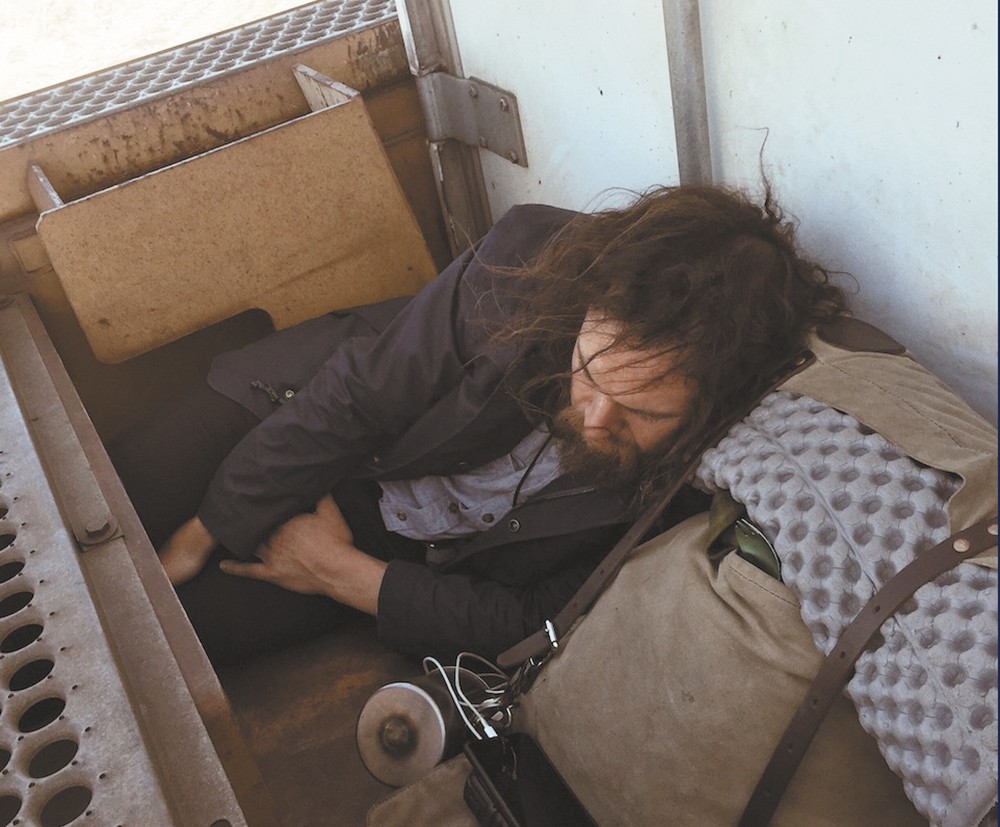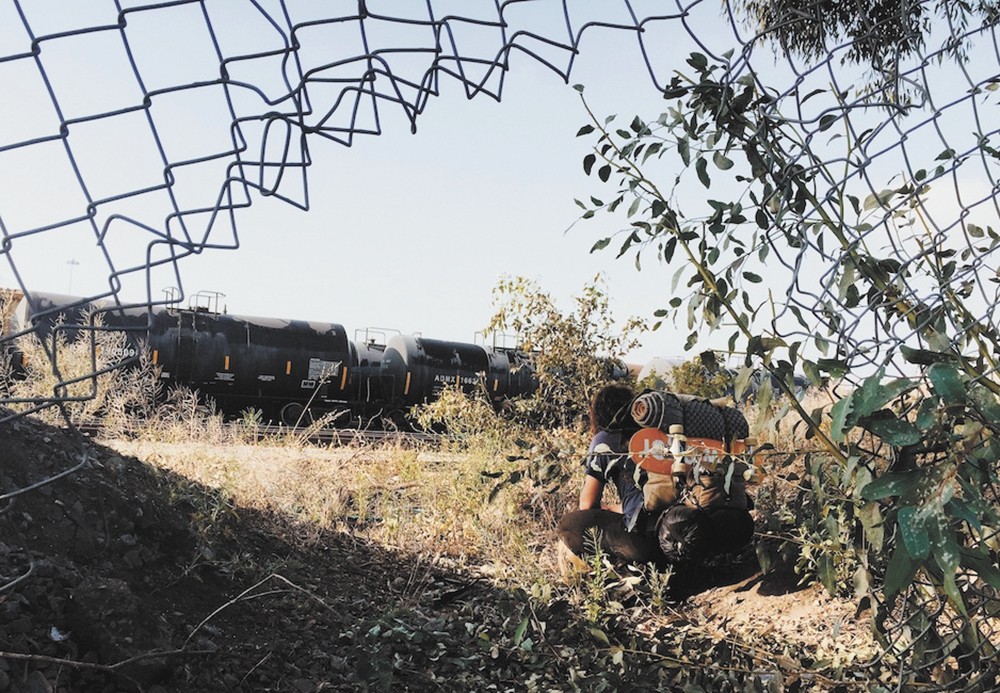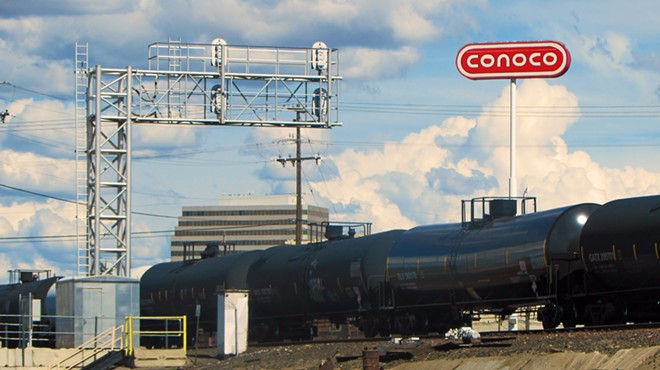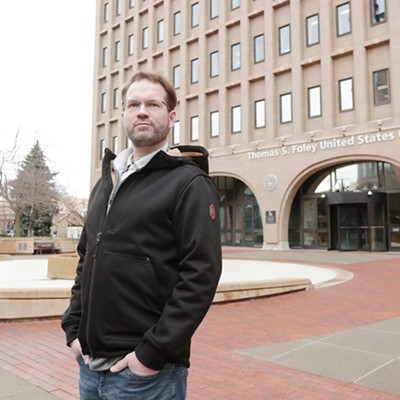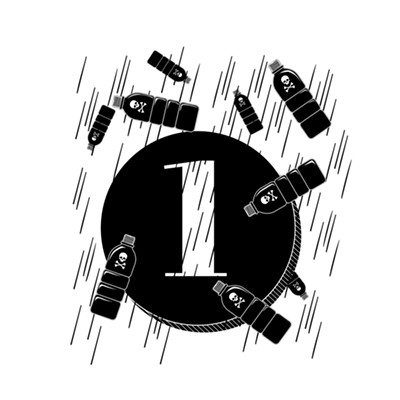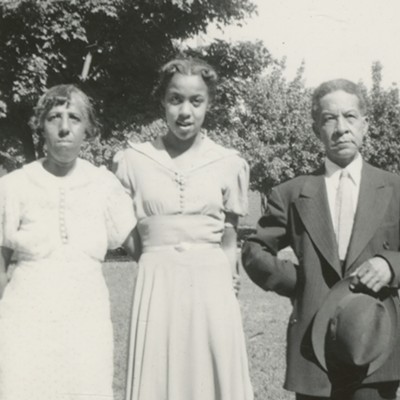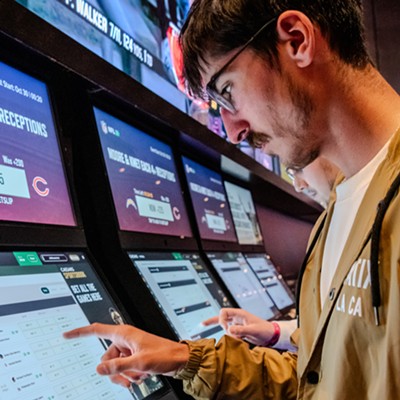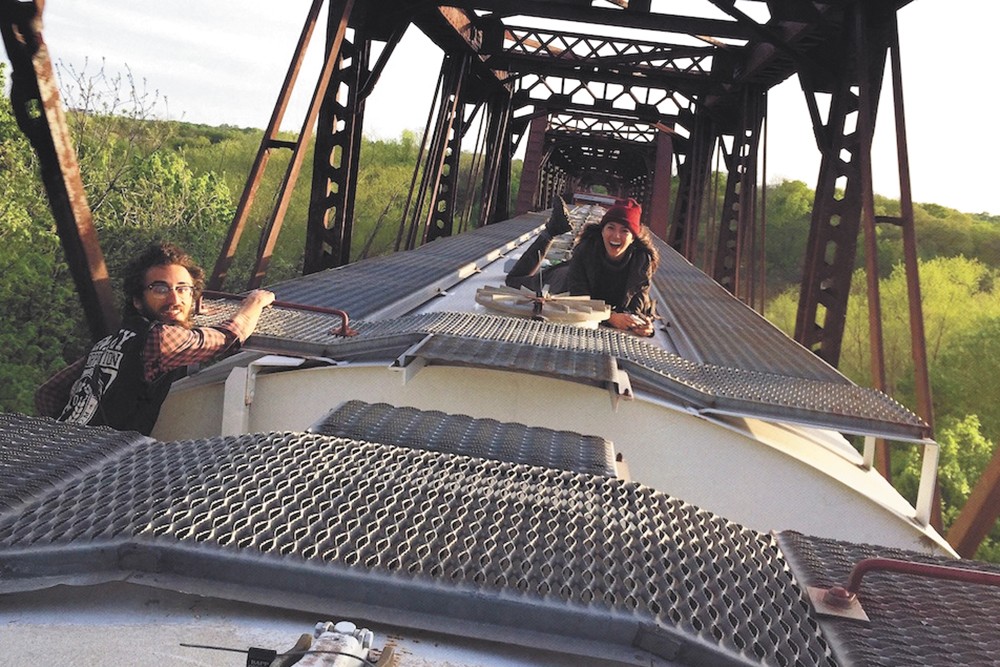
Chuck Lawrence is breaking Rule No. 1: Don't get too drunk.
You can't really blame him. He's been sleeping under a bridge in Missoula, a second coat wrapped around him like a blanket. Under his head is a backpack with all his worldly possessions: ramen noodles, a pocket knife, an old watch, a weed pipe, a can opener, bottled water and copies of his birth certificate and Social Security card. He's come to Montana looking for work, hoping to earn a quick buck to buy a proper bus ticket home to Minnesota. At 39, he's tired of this life, hitchhiking and hopping trains, town to town, circling the country counterclockwise for the past 20 years.
"The hell with this," he tells himself. "I'm goin' home."
He buys a bottle of Skol vodka at a corner store. Vodka's not usually his drink — he prefers beer — but it's going to be a long haul home, and vodka lasts longer. He takes a pull from the bottle and waits in the shadows of the Missoula train yard. He scans the tracks for rail cops, known by train hoppers simply as "bulls." Gusts of wind whip at his scruffy face as the sun dips below the horizon. When his train finally pulls in hours later, it's already too late: He's half shitfaced.
Chuck staggers toward the hulking steel box, as he's done countless times before, and hoists himself onto a grain car near the front of the train — his second mistake. He settles in for the ride with the twang of country music beating through his earbuds. The train kicks to life with a jerk, and he's on his way. Or so he thinks. Unbeknownst to Chuck, this particular train is headed west to Spokane.
He finishes the last of the vodka and shoves the empty bottle into his pack. Propped against an inside wall, he snuggles into his Carhartt jacket and pulls his stocking cap low. He drifts off to the train's hypnotic rumble. Things will be better in the morning.
Suddenly, he's jolted awake.
Braking hard just east of the Burlington Northern Santa Fe yard in Spokane Valley, the train flings Chuck, face first, toward the tracks below. His backpack explodes against the ground as he lands with a thud. His left leg doesn't clear the track.
Like a dull table saw, the train rips off his leg just above the knee. It's quick, but it isn't clean. Blood spurts from his mangled stump as Chuck writhes on the ground, screaming. Rolling on rock and in his own blood, Chuck's mind flutters in and out of darkness as he peers down at his nub, the wrong train continuing west without him.
Exploring the West
As long as there have been trains, people like Chuck Lawrence have been hopping them.
In the early 1880s, 44,016 miles of track ran throughout the United States, but only 1,124 miles of that reached the Pacific Northwest. By the end of the decade, that number jumped to more than 6,000. Huge railroads — the Union Pacific, Northern Pacific and Great Northern — raced to pound their rails deeper into the West, profiting from the burgeoning transcontinental trade. During that time, Spokane exploded into a major thoroughfare on the way to the coast. In 1880, Spokane's population was a mere 350. After the Northern Pacific railroad passed through the city in 1883, linking it to Minneapolis and Seattle, its population boomed — past 19,000 by 1890.
"The network of tracks... created the new 'Inland Empire' of agriculture, mining and logging all linked to the rapidly growing city of Spokane," writes Carlos Schwantes, a University of Missouri-St. Louis professor, in his book Railroad Signatures Across the Pacific Northwest.
When the Great Depression hit, those rails carried more than freight and paying customers. The promise of work lured desperate men — and boys — to the West, and more than a quarter of a million came by hopping freight trains. During that time, rail cops mostly turned a blind eye and took pity on the illegal riders in search of jobs.
Although train hopping was, and still is, very dangerous — there have been nine deaths on BNSF railways in Washington state so far this year — the early "hobo" lifestyle was romanticized as a free and easy, live-in-the-moment existence in books, movies and songs such as Woody Guthrie's "Hobo's Lullaby," Hank Williams' "Ramblin' Man" and Harry McClintock's "Big Rock Candy Mountain."
The glamorized portrayal of "hobos" persisted through the 1940s, '50s, '60s and '70s, but the attitude toward train riders shifted, as did the riders themselves. Burlington Northern Sante Fe spokesman Gus Melonas, who began his career in 1976 as a track inspector, remembers hobos of the 1970s regularly roaming through train yards, though they weren't the down-and-out types from decades ago. He still recalls talking to one man who was a Syracuse University professor "just out for a summer ride."
"They weren't the hippie, stoner types," Melonas says. "They were either the older, established hobos, or the thrill seekers."
Ted Conover, known for his narrative nonfiction books, is one example of those "academic hobos." His first book, Rolling Nowhere: Riding the Rails with America's Hoboes, took him through a circuit around the western United States. In the preface to a 2001 reprinting of the book, Conover writes of the changes to freight cars and the sentiment toward transients since his journey in 1980. He notes an increase in intermodal transportation, where container boxes from ships and truck trailers are loaded directly onto newer freight cars that offer less protection and hiding.
"But probably the worst thing for modern hobo life has been America's prosperity," Conover writes. "If train crews are a little less helpful to the guys they find in their yards, it may be because when they look at them they don't see themselves, dispossessed, but rather recreational riders or a newer wave of ... punks, radical environmentalists and other disaffected youth."
Lisa Schaffer, a former bull in Seattle's rail yard during the early '90s, still remembers two young girls she pulled off a train. She guesses they were 14 or 15. They wore layers of dirty clothing and were accompanied by a much older man armed with weapons.
"They were runaways. They just decided it was a good idea that day to hop a train and get out of town," she says. "It's something I've always remembered, and it's bothered me that there was nothing [more] I could do."
Railroads still house runaways and those who refuse to conform to the societal norms of suburbia and the 9-to-5 grind. Freeload, a 2014 documentary, follows a gang of teens and 20-somethings as they jump trains, dive through dumpsters and get drunk under bridges across America.
SKRAPPe (pronounced Scrappy), a modern-day hobo with greasy black hair and a bull ring in his nose, tells the filmmakers he'll never give up his life on the road.
"Who the f--- is gonna hire me?" he asks. "There ain't no job I can get. The road is my job. Holding a sign is my job. Riding trains is my job."
Technology hasn't escaped the 21st century hobo either. Thanks to sites like squattheplanet.com, hitchwiki.org and trustroots.org, modern-day train hoppers can stay connected with each other, ask for and offer rides and tell others about their experiences. Some post pictures to Instagram, and a cursory scan of Reddit reveals a wealth of insider tips and warnings.
After all, one slip, and you're hamburger.
Home and away
Chuck Lawrence was always independent, remembers Patrick Kordiak, Chuck's best childhood friend. The two meet in sixth grade in the mellow suburban town of Columbia Heights, Minnesota, and stay friends until high school. Chuck has an I'll-do-it-myself attitude and is the kind of guy who'd give you the shirt off his back, Patrick says.
Every morning before school, Chuck walks to Patrick's house a few blocks away to wake him up. While Patrick gets ready, Chuck sits and visits with his mom over coffee.
Once, when a kid in school starts picking on a classmate who can't defend himself, Chuck steps in and pummels the bully in the parking lot, Patrick says. He has a penchant for helping those who can't help themselves, though he refuses to accept the same courtesy from anyone else.
"He would fight anybody, anywhere, anytime," Patrick says of his 5-foot-8 friend. "He's the toughest guy I know."
Neither of them finish high school. Patrick needs a job to support a newborn baby, and a 16-year-old Chuck puts all his energy into starting a moving company with a relative. Chuck also starts hanging out with a different crowd — druggie types, Patrick guesses. Their friendship begins to fade.
Chuck's family moving company expands over the next three years. They start with one 24-foot-long truck and add employees and at least one more truck each year. Chuck is making $700 a week before tips.
But when he's 19 or 20, it falls apart. He's fighting with his parents, fed up with threats of being kicked out, so he quits his good-paying job and leaves Minnesota for the first time in his life.
He buys a bus ticket to Nashville because he loves country music. Naturally, he wants to be a country singer. He has a few tryouts, but it goes nowhere. He gets some work at a fast-food restaurant and spends his money on beer watching others play music. Tootsies and Legends Corner, two famous honky-tonks, are his favorites.
He finds himself camping under a bridge with a group of older men. One in particular, Julio, a well-known homeless man with a long ponytail, shows him the ropes. Soon, Julio and the boys are bragging about the places they've been, the people they've met, while hopping trains. All night, over beers, the men rave about the beauty of the Western countryside — mountains, bridges over crystal-clear water, breathtaking sunsets and more stars than you could ever see in Nashville.
They also teach Chuck the right way to ride trains. There are things you need to do, and stuff you need to bring:
• Don't forget the beer. You might want to get buzzed for the long rides, but you'll still need your wits about you.
• Ride on the back of the train. If you fall off, you won't get run over. Plus, there's less wind, and you'll be able to jump off before the train stops in the yard.
• Hold on tight. Trains make sudden stops and jerk constantly. It's easy to get thrown off.
• Be quiet. Bulls are cracking down on train jumpers. Even stepping foot in a train yard is considered criminal trespassing.
• Always carry ramen noodles. Always.
Chuck is immediately hooked — "I guess you could call it an addiction," he'd say — and not just on the adrenaline surge that comes with eluding the bulls and sucking the fresh air that heaves past the train. The things he sees chugging across bridges hundreds of feet high and through mountains untouched by roads will give him goosebumps. Alligators in secluded Mississippi swamps, bright golden Kansas wheat fields swaying in the wind like ocean waves, water like perfect mirrors reflecting the scenery above.
Chuck begins traveling in a circle, counterclockwise around the country. West through the Dakotas, stopping for supplies (water, food, beer, smokes), onward to Spokane, to Portland, down into California, hitching along the Pacific Coast Highway, where ocean bashes into cliffs. He'd hang a left into Arizona, New Mexico, Texas and Louisiana. By the time he gets to Florida it's usually summer, and he heads north to Minnesota and checks in with his mother.
If he doesn't like a city along the way, he leaves. If he finds good work or a party, he stays until it runs out, or until the itch for the road grows too strong. He works as a landscaper and a mover, but most of his experience is in restaurants. He does everything from fry cook at Del Taco and Burger King to prep work at white-linen restaurants where you'd better have a reservation.
The last time Patrick sees Chuck is 10 years ago when he returns to Minnesota. Patrick offers to help get Chuck a job, but he refuses, saying he can do it on his own. Chuck doesn't figure to stay long anyway.
"He said he loved being on the road," Patrick recalls, "and that he couldn't see himself doing anything else."
Travel companions
Chuck usually travels alone, but then he meets Laura. She has fair skin, red hair and a rockin' body. She's a farm girl who'd never been out of Minnesota, and she wears nerdy farm-girl outfits — ugly glasses, plaid and overalls. Chuck will later say, "She didn't know she was pretty. Like the country song."
They meet about 12 years ago in Minnesota, while he's taking a break from his nomadic life to save up some cash and spend time with his mom. He works at Arby's, and Laura lives in the apartment complex across the street. One day, Laura is walking outside, and she bends over to pick something up. Chuck gives her the "whoo-hoo!" from the drive-through window.
Insulted, Laura storms into the Arby's to berate whoever just whistled at her. Chuck confesses and says he meant no harm. Those pants just looked good on her. He tells her his birthday is coming up and asks her to join him for dinner when he gets off work.
Laura agrees, and as Chuck tells her of his adventures on the road, she finds herself growing more interested in the mysterious rover who works the Arby's drive-through. After dinner she invites him back to her place for a nightcap.
The two end up dating, and just as Julio had done for Chuck, he plants the seed for Laura. His tales of riding the rails enthrall her, and the road seems like a good escape from the issues she's having with her family.
The first train they hop together is an oil tanker heading toward Iowa. Unlike grainers or gondola cars, there's nowhere to hide on an oil tanker, and the couple gets kicked off somewhere in a cornfield. They hoof it to the nearest road, where a farmer gives them a lift to the highway. The next train takes them through South Dakota, Montana and Idaho, and eventually they end up in Washington. They hitchhike through Oregon and into California, following the same route down Highway 101 to State Route 1 that Chuck has carved several times before.
As the couple hitchhikes down the coastline, Laura is in awe. It's her first time seeing the ocean. The months wear on, her pale skin turns bronze and the sun highlights her hair. Chuck's Minnesota girl-next-door transforms into a West Coast hottie.
When they stop along the coast, Chuck drinks beer while Laura reads. They survive by flying a sign that reads "Hungry Hitchhikers" and eating ramen noodles and tuna. On the trains at night, the vagabonds snuggle beneath a king-sized comforter and make love under the stars.
It takes about a year for Chuck and Laura to reach Florida, and they talk of settling down. He wants a job and a life and a cute little kid running around. So they hitchhike up through Georgia, Tennessee, Kentucky, Illinois, Iowa and back home to Minnesota, where they stay with Chuck's mom.
But as the euphoria of the road fades, Chuck gets restless. He starts drinking more. He and Laura fight too much.
Soon after they split up, she gets pregnant by a guy who skips town. She comes looking for Chuck, wanting to get back together. He refuses and returns to the road. Chuck's story of Laura will end there: "So that was the end of her."
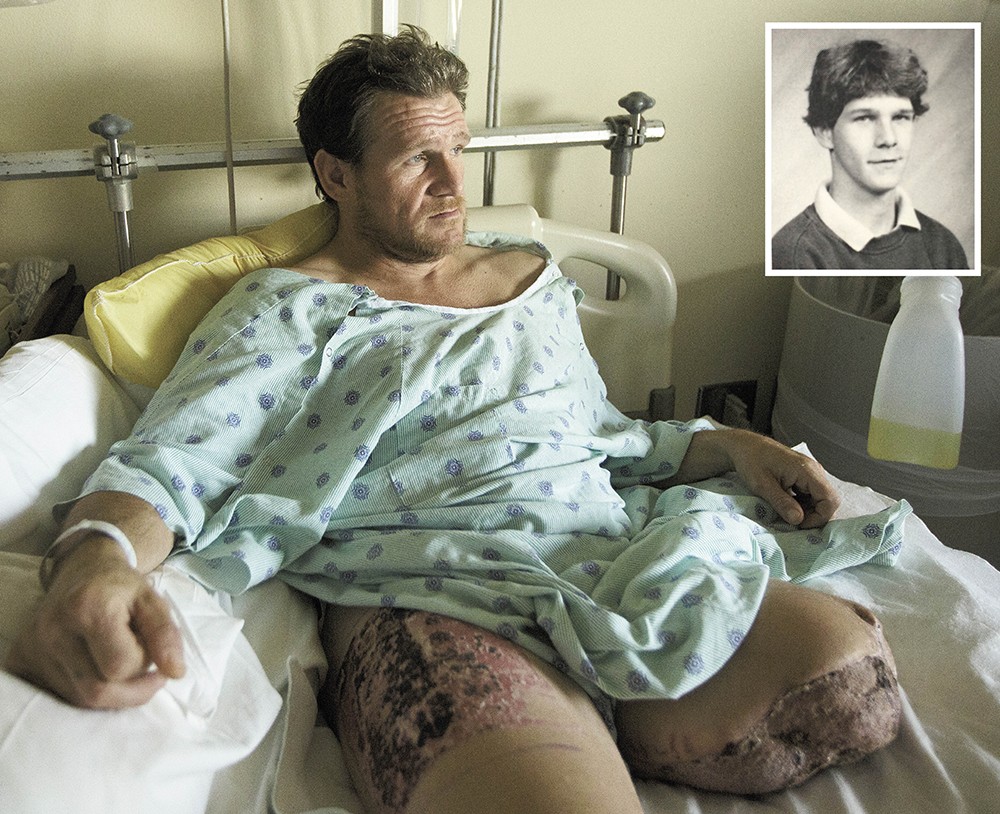
Recovery room
Now Chuck Lawrence spends his days wheeling around an in-patient rehab center in Spokane, an upgrade from his hospital bed at Sacred Heart Medical Center, where the only things he had to look forward to were the next doses of his pain meds and more bland hospital food. He has trouble sleeping at night. The nerves in his severed thigh fire constantly, and between bites of pizza shared with a reporter, he reaches down and touches the sheets where his left leg should be.
"I can feel my toes," he says. "I'm wiggling them right now."
He's learning to use a walker during daily physical therapy sessions — Medicaid is picking up the tab — but after rehab, he's on his own. He's not sure what comes next. He had wanted to return home, reconcile with family, maybe start his own. For now, he's stuck in Spokane.
"I have no idea why I'm not hamburger. ... But things happen for a reason."
Over the course of eight conversations for this story, Chuck recounts everything. Leaving Minnesota, pissed at his family. Learning his mom had died while he was out on the road. Laura. Patrick Kordiak. The first time he saw the ocean cliffs along State Route 1. The road and tracks and adventure.
"I'm getting goosebumps right now just thinking about the things I've seen on a train," he says.
"The first 10 years were fun. I worked with a lot of great chefs, and I've seen and done a lot of things. The next five or so, it got old. I needed to slow down, and you're catchin' me at the end of getting sick and tired of doing this shit. This is the result of me not slowing down soon enough."
Chuck doesn't remember the trip to the hospital, just that last moment of being ejected from the train, hearing a loud snap! and staring at the mutilated remains of his leg.
It takes almost two hours for help to arrive. Conductors on two different trains radio the bulls to report a man lying on the side of the tracks. One of the conductors reports seeing body parts strewn across the tracks just beyond where the man lay, according to the police report.
BNSF Special Agent Pete Seymour searches for almost an hour after the first call at 8:30 am on April 5, but can't find anyone. The second call comes in at 9:51, and Seymour calls for backup. He finally finds Chuck near the dirt access road, just south of the tracks. The train had dragged his bloody boot and parts of his leg farther down the rails.
Seymour finds them, along with a "sizable fragment of flesh," according to the report. The sweet smell of alcohol drifts from the pools of thick blood.
"I need help" are the only words Chuck can muster when Seymour finds him writhing on the dirt and rock. ♦
Deadly Decisions
From 1980 through 2012, trespassing deaths on railroads throughout the country have fluctuated between about 390 and 550 per year, according to the U.S. Department of Transportation.
BNSF spokesman Gus Melonas says there have been nine deaths on Washington state's BNSF railways so far this year, including a 17-year-old girl killed last weekend in Western Washington.
According to Operation Lifesaver, a railway safety organization, trespassing deaths and injuries on railroads nationwide have increased by 10 percent from 2013 to 2014, jumping from 863 to 945. Of those 945 cases in 2014, 526 resulted in death, an increase of about 22 percent from 2013.

